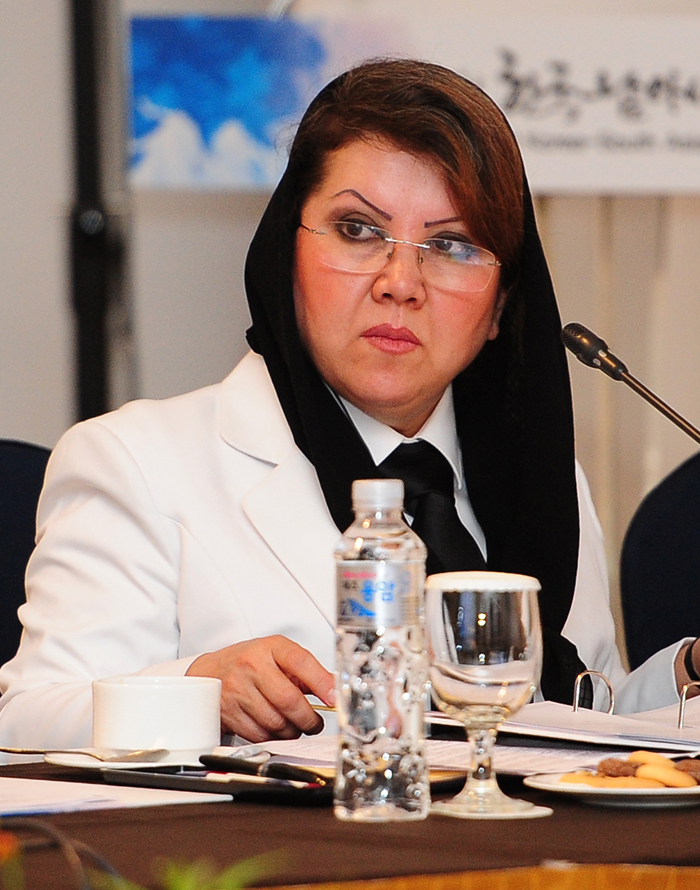
Afghani Deputy Minister of Information and Culture Simin Hassanzada
Keynote speech by Simin Hasanzada, Deputy Minister for Ministry of Information and Culture, Islamic Republic of Afghanistan.
His Excellency, Korean Minister of Culture, Excellencies South Asian Ministers of Culture, ladies and gentlemen.
Enjoying plenty of attractive scenic geography and nature and wide number of historical heritages, Afghanistan had long been the hub of the tourists’ visit, particularly during the prewar periods, large number of tourists have been visiting the country’s ancient sites and cultural heritages.
These historical monuments are located in some provinces of the country, such as Bamyan with gigantic Buddha Statues drew attention of large number of tourists from different Asian and European countries.
But, unfortunately, the last several decades of war and turmoil resulted in destruction of most of the historical monuments and despites efforts by the ministry of information and culture to repair and reconstruct them, there are still 1400 monuments and 500 ancient sites at the edge of ruin and destruction in the country.
The international community and the friendly countries are hoped to pave the way for full rebuilding and reconstruction of the historical monuments, which are part of the world cultural heritages, among them, reconstruction of Jam Minaret, with 1200 years of historical background, which is at the edge of devastation due to heavy seasonal and natural incidents, as well as the great Buddha Statues, which are reportedly facing full annihilation from the seasonal and natural disasters.
Nevertheless, Afghanistan is a country, with hidden precious cultural and historical treasures, for which Ghazni City is selected as the Islamic World Cultural and Civilization Center (Cultural Capital of the Islamic World) that the inaugural and closing ceremony was attended by many high ranking governments’ officials from different countries in 2013.
This year, the proposal for the ancient Bamyan City, with its numerous historical sites and monuments was accepted to be introduced as the cultural center of the South Asia Association for Regional Cooperation (SAARC) in 2015.
What is to be mentioned, is that despites negative impacts of war on the cultural situation that resulted in destruction of parts of the country’s cultural heritages and historical monuments, the Islamic Republic of Afghanistan and the ministry of information and culture could make efforts in the last 13 years, to reconstruct and protect the ancient sites and historical monuments across the country.
Afghanistan has developed in different cultural scopes, particularly, in the area of art, cinema, theater, music, portrait, photography, literature etc., with the most pioneers could be lauded as the young generation.
National and international artistic and cultural festivals are annually being held in the country, with an Afghan film displaying the human rights situation was exhibited in western Herat province and gained the first position as well as the woman film directed by an Afghan woman Ms. Roya Sadat which could gain high position.
We are also witnessing national festivals displaying Afghan music, and participation of the Afghan artists in the international festivals, among them, in Turkmenistan, where the Afghan musicians could gain first position in Nawroz festivity.
Holding international Book-Show can also be one of our great cultural achievements, demonstrating that Afghanistan is making effort to rehabilitate its cultural dignity and find its position alongside regional and world nations.
The three times gaining of first positions by the Afghan publishers in the Tehran International Book-Show is another cultural achievement of the Afghans. And the Afghan youth had also gained many successes in cultural fields, as the Afghan painters, photographers and artists could attend the world art and cultural programs.
There are tens of film producing companies, in which the Afghan youth are involved in different fields of art and culture.
In the current year, Afghanistan hosted another splendorous Nawroz Festival in which authorities from different countries such as Turkmenistan, Iran, Pakistan, Tajikistan and authorities from India and Turkey had attended.
The festival was splendidly held with the Afghan handicrafts being displayed, local meals offered, traditional games and dances played.
In conclusion, as a country with 5,000 background of cultural and historical heritage, Afghanistan is in dire need of the friendly countries and the international community’s cooperation to be paid in the reconstruction and repairing of the ancient monuments.
The cooperation could be eased by providing the required materials and equipment, training cadres and sending professional and skilled individuals and the move can help us reach our cultural targets, as Afghanistan’s cultural heritages affluence could be described as the world cultural improvement and Afghanistan would forever be appreciative of all the culturist countries.
Most popular
- Slew of festivals, events scheduled in downtown Seoul in May
- Korea.net welcomes 2025 K-influencers, Honorary Reporters
- 2025 Honorary Reporter class pledges to spread 'real Korea' worldwide
- US urged to exempt tariffs on Korea in first '2+2' trade talks
- Korean culture festival in Cuba marks 1st year of bilateral ties
